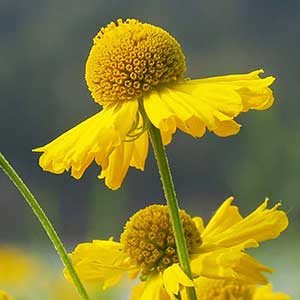Helenium autumnale
Helenium vernale
common sneezeweed, fall sneezeweed, hélénie automnale, large-flower sneezeweed, mountain sneezeweed
savanna sneezeweed, savannah sneezeweed, spring sneezeweed
1(–7), branched distally, strongly winged, sparsely to densely hairy proximally, moderately to densely hairy distally.
usually 1, usually unbranched distally, weakly winged, glabrous proximally, glabrous or sparsely hairy distally.
usually moderately to densely hairy, sometimes glabrous;
basal blades (withered by flowering) lanceolate, oblanceolate, or obovate, entire or weakly lobed;
proximal and mid blades obovate to oblanceolate, usually dentate or entire;
distal blades oblanceolate to lanceolate, entire or dentate.
usually glabrous, rarely sparsely hairy;
basal blades obovate to narrowly oblanceolate, usually entire or undulate to undulate-serrate;
proximal and mid blades usually narrowly lanceolate to narrowly oblanceolate, usually entire, sometimes toothed;
distal blades lance-linear, entire.
3–10 cm, moderately to densely hairy.
2–23 cm, usually glabrous, sometimes sparsely hairy.
globoid, 8–20 × 8–23 mm.
hemispheric, 10–17 × 15–27 mm.
8–21, pistillate, fertile;
corollas yellow, 10–23 × 4–10 mm.
13–30, neuter;
corollas yellow, 15–21 × 5–10 mm.
200–400(–800+);
corollas yellow proximally, yellow to yellow-brown distally, 2.4–4 mm, lobes 5.
150–650(–800+);
corollas yellow proximally, yellow to yellow-brown distally, 4.6–6 mm, lobes 5.
(connate proximally) moderately to densely hairy.
glabrous or sparsely hairy.
5–70(–100+) per plant, in paniculiform arrays.
1(–3) per plant, usually borne singly.
1–2 mm, sparsely to moderately hairy;
pappi of 5–7 entire, aristate scales (0.5–)0.9–1.5(–1.8) mm.
1–1.5 mm, glabrous;
pappi of usually 8 entire or lacerate, non-aristate scales 1.5–2 mm.
= 32, 34, 36.
= 34.
Helenium autumnale
Helenium vernale
The name Helenium nuttallii A. Gray is illegitimate; it has been applied to plants treated here as H. vernale.
(Discussion copyrighted by Flora of North America; reprinted with permission.)
- Local floras:
BC,
CA,
OR,
WA
- Local Web sites:
CalFlora,
CalPhotos,
Flora NW,
Go Botany,
IL Wildflowers,
KS Wildflowers,
LA Plants,
MD Biodiversity,
MI Flora,
MO Plants,
PNW Herbaria,
Turner Photog.
WildflowerSearch
iNaturalist (observations)
USDA Plants Database
- LBJ Wildflower Center
- SEINet
- Plants of the World Online
- Encyclopedia of Life
- Wikipedia
- Google Image Search


